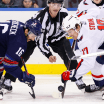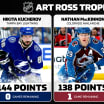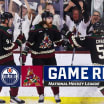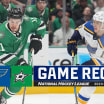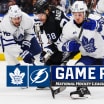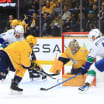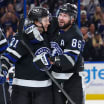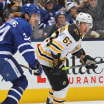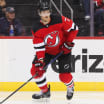5 things learned at Central Scouting final meeting
Gap between Hughes and Kakko, updated NHL Draft prospect grading system among topics
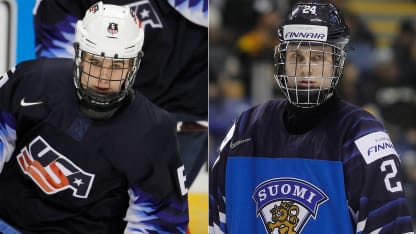
But how big is the perceived gap between the 17-year-old center and forward Kaapo Kakko of TPS in Liiga, the consensus second-best player available?
"Consideration for No. 1 has expanded to a 1A and 1B ever since the 2019 World Junior Championship, where Kakko had a strong performance on the world stage and continued his impressive play in Finland's Liiga," NHL Central Scouting director Dan Marr said. "Meanwhile Jack Hughes continues his wizardry scoring and playmaking, displaying his quick wits and speed while setting all kinds of scoring records."
Hughes (5-foot-10, 170 pounds) leads the NTDP U-18 team with 86 points (23 goals, 63 assists) in 41 games, and has set NTDP records for career assists (134) and points (197). Kakko (6-2, 194), an 18-year-old right wing, had five points (two goals, three assists) in seven games and scored the game-winning goal in the gold-medal game for Finland against Hughes and the United States at the WJC, and had 38 points (22 goals, 16 assists) in 45 games for TPS in Liiga.
There will be no final head-to-head matchup to judge them. Hughes next will play for the United States at the 2019 IIHF World Under-18 Championship, while Kakko is opting to try out for Finland's team for the IIHF World Championship.
Marr led Central Scouting in its final meeting this week, which determined the final rankings of the top 217 North American skaters and top 31 North American goalies for the 2019 Draft (final International rankings will be set next week). He doesn't have to pick which prospect he would take.
"It will be a win-win scenario for the clubs selecting No. 1 and No. 2 in the 2019 NHL Draft," he said.
Here are four other things learned during NHL Central Scouting's final meeting:
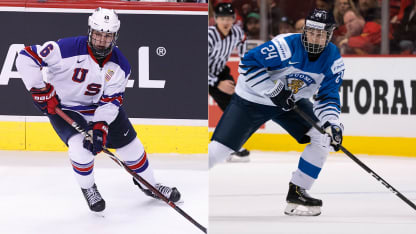
© Getty Images
What is the position of strength in the 2019 NHL Draft?
When the first round of the draft is held at Rogers Arena in Vancouver on June 21, the scouts expect most of the players picked to come from the deep well of highly skilled forwards available.
Hughes was the first of nine forwards, including seven centers, among the top 11 in the midterm ranking of North American skaters. Defensemen Bowen Byram (No. 4) of Vancouver in the Western Hockey League and Thomas Harley (No. 9) of Mississauga in the Ontario Hockey League were the exceptions.
"Not every kid playing center now is going to play center at the NHL level; some will play wing," Central Scouting's Karl Stewart said. "But [the draft] is not as strong defensively. I find that it really drops off after maybe four or five defensemen, and then you're starting to project a little more."
How has Central Scouting evolved its process?
Marr oversees a department of eight full-time scouts and 16 part-time scouts throughout North America. The NHL also employs Goran Stubb and his five-member staff at European Scouting Services, based in Finland, to evaluate prospects in Europe.
In addition to its publicly released rankings, Central Scouting also provides NHL teams with game report evaluations and checklists, which are summaries of skills and attributes of each ranked player.
Marr said Central Scouting has spent the past two seasons updating how it evaluates prospects.
"Two years ago we updated the terminology, grading and scoring of the game report evaluations, and this year the checklists," Marr said. "It's an important function for Central Scouting and the NHL clubs to review these assessment tools from time to time and make these adjustments to reflect the changes and trends that have occurred in the game.
"For example, there is less weighting or emphasis on the size factor than in the past and a more measured or re-emphasized weighting placed on smarts, compete, speed and skills. For Central Scouting, these changes have helped improve the efficiency of our work product during our meetings, which ultimately is reflected in the final rankings that are provided to the NHL clubs."
What are the benefits to scouts having the NHL Draft Lottery on April 9 instead of later in the month?
It's a huge advantage to NHL personnel to be able to prioritize where they want to go and who they want to see in the two months leading up to the draft.
"NHL general managers requested the Draft Lottery be held earlier in order for clubs to know where they will be selecting at the draft, affording them the opportunity to target their scouting resources during junior playoffs and the [2019 IIHF World Under-18 Championship]," Marr said. "This is the time of the year that GM's will watch the draft prospects that their scouts have identified. Knowing where your club is selecting is important when getting final views on a prospect."
Is this season's NTDP U-18 team the most talented since the program's inception in 1996?
In addition to Hughes, there were seven players from the NTDP that were projected as first-round candidates in the midterm rankings: forwards Alex Turcotte (No. 5), Matthew Boldy (No. 6), Trevor Zegras (No. 7), and Cole Caufield (No. 15), defensemen Cameron York (No. 12) and Alex Vlasic (No. 25), and goalie Spencer Knight (No. 1 among North American goalies).
"The U.S. NTDP this year has the most depth of prospects of any team in the history of the program," Marr said. "At one point every player was ranked, and it's possible that this year's team may set record for the most first-round selections and most overall selections than any other draft class. They are a very special group."


